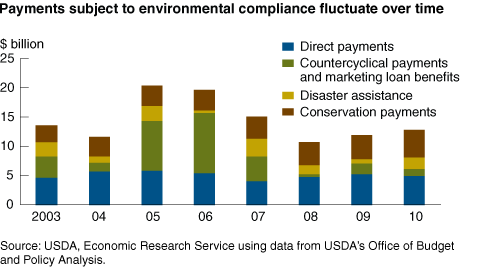Farm Program Changes Could Affect Environmental Compliance Incentives
- by Roger Claassen
- 6/5/2012
Federal farm program payments help encourage good stewardship of natural resources through environmental compliance requirements. To maintain eligibility for most farm programs, farmers must follow an approved soil conservation plan on all 'highly erodible land' (HEL) used for crop production (about 25 percent of U.S. cropland is highly erodible) and refrain from draining wetlands for crop production. Farmers who do not comply with these requirements, even on a small number of acres, risk losing some or all of their Federal farm commodity, conservation, and disaster payments as well as access to Federal farm loan and loan guarantee programs.
Previous ERS research found that environmental compliance accounted for as much as 25 percent of the reduction in soil erosion in the U.S. between 1982 and 1997, a savings of roughly 300 million tons of soil per year. The same study showed that environmental compliance was protecting between 1.5 million and 3.3 million acres of vulnerable wetland, although higher crop prices in recent years may have increased the number of wetland acres that could be profitably drained for crop production.
Since 2003, annual farm program payments subject to environmental compliance have fluctuated between $11 billion and $20 billion. Most of the variation can be attributed to countercyclical payments (CCP) and marketing loan benefits (MLB). These commodity payments are triggered by low crop prices, so they tend to be high when crop prices are low. Since 2007, high prices for most program crops have sharply reduced CCP and MLB payments from their 2005-06 levels.
Conservation incentives are affected by the number and size of programs subject to compliance rules. Thus, the future effectiveness of environmental compliance requirements may be affected by the evolution of farm programs in the next farm bill, scheduled for debate in 2012. Due to Federal budget pressures, direct payments--fixed payments based on historic production--may be sharply reduced or eliminated. Direct payments have accounted for roughly half of the compliance incentive since 2008. If they are eliminated, farmers who do not receive conservation or disaster payments (the other major payments subject to environmental compliance) may have less incentive to continue meeting compliance requirements unless these payments are replaced by another type of commodity program subject to compliance. Making crop insurance premiums subject to compliance could also compensate partially for lost compliance incentives if direct payments are eliminated. Between 2005 and 2010, the Federal Government paid roughly 60 percent of crop insurance premiums, or an average annual expenditure of roughly $4 billion over the 6-year period. About 80 percent of eligible acres for the four major program crops (corn, soybeans, wheat, and cotton) are covered by crop insurance.
This article is drawn from:
- Claassen, R. (2012). The Future of Environmental Compliance Incentives in U.S. Agriculture. U.S. Department of Agriculture, Economic Research Service. EIB-94.


